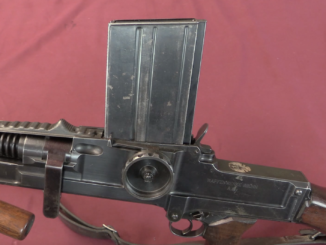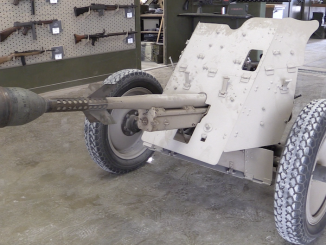Note: When I say the double magazine pouch is unique for this model, I was not thinking about those issued with LP-08 Artillery Lugers.
While the Dutch Army dithered over new pistol adoption, the Dutch East Indies Army (KNIL) took more decisive action and adopted the Luger as the M11 in 1911 after a few years of testing. They ordered the first batch of 4,181 from DWM in the years before World War One. After the Treaty of Versailles German companies were barred from military production, and so the KNIL bought a batch of 6,000 Lugers from the Vickers company in the UK. These were still insufficient for the force, and in 1928 they ordered one final batch of guns.
This final batch was made by DWM. The Allied Control Commission ceased operation in 1927 and left Germany, and DWM almost immediately resumer Luger production. This final batch consisted of 3,828 more M11 pattern pistols. All three batches were in a single serial number range, starting at 1 and running to 14020. They were chambered for the 9x19mm Parabellum cartridge, with 4 inch (100mm) barrels. Unit marks were engraved originally on the back of the frame, but in 1919 this was replaced with the use of a small brass plaque on the trigger guard. A plaque on the left side of the frame was introduced for unit marks in 1939, as seen on this example.
We also have an original KNIL M11 holster and double magazine pouch to take a look at – accessories that are extremely rare today.




When the KNIL could have bought the Browning M1900, M1903, M1905, M1911 or M1922, they went with this German trash whose toggle action just pumped crap into the mechanism and chamber. In the jungle. Can you say “stoppages”, kiddies? And they had a switch that told the weapon to go ahead and rust…
Do you know that from historical accounts? The mud tests over at InRange seem to show that the Luger was actually quite reliable even when dirty. John Walter’s book indicates that the greatest threats to Luger reliability were mismatched parts and weak ammunition. If the Dutch colonial service were already stocking 9×19 ammo, what other suitable pistol was available? (Red-nine Broomhandles?) Not any Browning. And I presume you are joking about “rust.”
If KNIL was really stocking 9×19mm ammunition, a question arises: for what? There weren’t too many pistols chambered for that cartridge before WW1. The Luger was by far the most important one. It seems to me that 9×19mm was chosen because it was the best round for the Luger available “off-the-shelf and not the other way around.
Any Luger would be last in line for a good choice for tropical climates due to the intricate machine work involved with attendant tight tolerances that would make for maintenance and reliability issues and give armorers nightmares. The 9mm Parabellum is a fine cartridge for issue in any climate, but the platform using it really should be more like the Colt/Browning 1911 plug and play style of easier maintenance. Any thoughts Ian?
The “Lugers are unreliable” thing is mostly a canard.
It derives from WW1 trenches where – guess what? – absolutely everything malfunctioned in mud, snow and freezing rain unless meticulously given preventative maintenance, which mass conscript armies are not good at.
And it strongly derives from US hobby shooters and gun writers post-WW2 using US-made 9mmP ammo. Back then, it was loaded weakly (I don’t know why – maybe fear of it being used in WW1 surplus Glisenti/Brixias?). Use a cartridge that makes 1400fps not 1200, and the Luger works well. If you are an army, you buy the gun and the ammo as a package. It matters not one iota to you that Remchester 95 grain JSPs hang up on the feed ramp, because you aren’t using them, even if that fact spoils some guy’s Saturday morning on the local range.
Yes, too much of the mechanism is exposed to the elements. Yes, it has some tight tolerances. Yes, a 1911/GP35 would have fewer issues. But the Luger successfully passed many trials, was used by dozens of armies, was retained by the Germans through WW2 and by many others including the Portuguese in actual colonial conflicts until the 70s. That would not have happened if it wasn’t adequately reliable.
“…It derives from WW1 trenches where…”(C)
This comes from Soviet propaganda.
When the peasants, accustomed to revolvers, simply did not know how to properly maintain this pistol.
Well, the pistols themselves, which reached the “test” being already pretty worn out.
A similar story was with the “tests” of the M16 rifle.
A serviceable and properly trained Luger is reliable enough.
In any case, it is much more reliable than the 1911A1 and TT33.
There is so much opinion and mythos, and so few reliable source and test…
Fortunately there is Karl’s test on the InRangeTV: Mud Test: WW1 & WW2 P08 Luger
https://www.youtube.com/watch?v=z_IeAaR5AmU&ab_channel=InRangeTV
(Yes: this is only one sample and only one test. – But one more than nothing.)
I think the barrel has been replaced.
On the upper, traces of a locksmith’s vice are visible.
And the font on the barrel seems to be slightly different from the font on the frame.
Most guns don’t need a special control to engage rust mode 😉
Regarding reliability, there’s a very good reason why some guns have serial numbers or assembly numbers stamped on lots of parts
They’re selectively assembled, and possibly even hand fitted.
The American literature is full of oft repeated myths and half truths
Lugers unreliable… if they’re worn out, have misfitting or damaged parts and, yes, American commercial 9mmp was way underloaded.
Lee actions with excess headspace… yes, because American importers brought in a lot of scrapped rifles that the case hardening had worn through on the locking seats.
Carcano rifles “weak”
unless they’re completely worn out, absolutely not, in limited testing they’re actually amazingly resistant to letting go. With the correct diameter bullets, they can also be surprisingly accurate.
I think it’s time to go to roost 😉
The loaded chamber indicator may or may not be marked in German. It’s the same word in both languages.
I would love to know what this sells for at auction. Ian, please let us know when the auction is over.